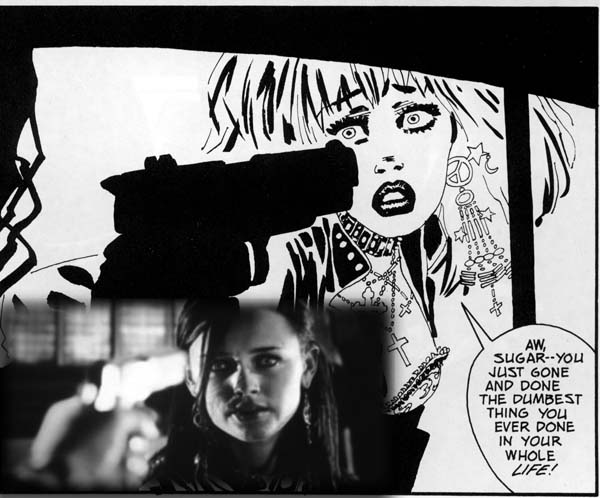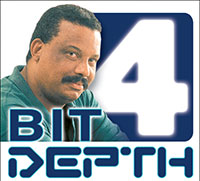BitDepth 472 - May 10
11/01/09 17:42 Filed in: BitDepth - May 2005
The Sin City film tracks so closely to Frank Miller's graphic novel that you can't help but play "spot the comics panel."
Naked violence in a sinful city

Sin City synchronicity. On the comic page and in the film, Jackie Boy threatens Becky and precipitates the events of "The big fat kill". These "panels jump to life" moments make up almost half of the film.
Sin City, a new and groundbreaking film from Robert Rodriguez and Frank Miller, is both impossibly beautiful and unbearably violent. It lifts its influences equally from the brute perambulations of pulp fiction and the silvery gray tones of film noir classics, those elegantly beautiful black and white films in which highlights shone like diamonds against stygian darkness.
In Basin City, women are generally whores blessed with gilded hearts and men are dumb brutes with a gun in one hand and their zipper in the other.
The questionable heroes of these tales are bad men trying to do one good thing before they come to a terrible end. Driving them is a seriously dented sense of honour and a passion for hot women who are endlessly just out of reach.
What's particularly startling about Sin City is that it is such a faithful realisation of the original comics by Frank Miller. Not an adaptation or an interpretation, the films follow the script and panels of the original books as if they were storyboards, not comics.
Now Frank Miller is no stranger to popular entertainment. Apart from his celebrated runs on Batman, in which he imagined the crimefighter as a surly, ageing anachronism of left wing justice, he has also written instalments of the Robocop films and his work on Marvel's Daredevil was lifted willy nilly to create the film starring Ben Affleck. His creation for Marvel, Elektra, was suborned to continue that red spandex franchise in a perfectly awful spinoff.
It's safe to say that he's been roundly hammered by the Hollywood film machine and has steadfastly and unsurprisingly resisted selling the rights to the Sin City graphic novels, which he owns and publishes through Dark Horse comics.
Smart move, Frankie boy, as he might have one of his loutish characters say.
Robert Rodriguez was smitten enough with the content of the books to decide that the film was already written and blocked and offer Miller a co-director's chair (which cost Rodriguez his membership in the Director's Guild and John Carter, Warlord of Mars).
Unlike previous comic book films, this one isn't adapted or interpreted, it's transferred almost completely from the printed page to the screen, the only changes being a reduction in nudity and profanity in the film and a few nips and tucks that Miller clearly approved of.
None of this would have been possible without the miracle of digital video, which allowed Rodriguez to shoot in high definition DV, composite the live action with rendered backgrounds, strip the colour except for artful (and occasionally gratuitous) splashes that mirror the spot colour on black and white style of the original books and deliver a breathtaking vision of well-lit squalor.
It's pretty safe to say that Sin City is everything that Kerry Conran's Sky Captain was not. Conran took pretty much the same technology route to realising his universe, but Sky Captain was an empty, silly adventure, Marv, Dwight and Hartigan are on baser, more compelling missions.
The film stitches together three stories from the Sin City books, "The hard goodbye", "The big fat kill" and "That yellow bastard", with a bookend sequence inspired by the short story "The babe wore red" in an interlocking style that's reminiscent of Tarantino's Pulp Fiction. But it's a vanity, really. They could have told the stories sequentially, because except for shared perspective scenes in a bar where all the leads brush past each other; the stories have little in common.
Well, except for the remorseless savagery. In Sin City, rain is the only relief from the eternal night and everyone's a rat trapped in a maze of wrong turns and our heroes must blast their way out of it with guns and fisticuffs.
Miller created the Sin City series as a ferocious response to the timidity of mainstream comics, and the lame response of creators to new avenues available for creator-owned works. If I can do anything I want to, Miller must have reasoned, then I'll do this.
Unfortunately, the brutal morality plays he created that soar in the novella/longish short story format of his comic series grow numbing when so many of them run together. "Hey," I caught myself saying as one more head was plunged into a toilet, "there are turds floating around in there."
Perhaps the coolest thing about Sin City's success is that Frank Miller, who plays a corrupt priest in "The hard goodbye" not only has the altogether unique experience of seeing his work translated verbatim onto the screen, he now has his own personal Sin City story, "The big payoff".

Sin City synchronicity. On the comic page and in the film, Jackie Boy threatens Becky and precipitates the events of "The big fat kill". These "panels jump to life" moments make up almost half of the film.
Sin City, a new and groundbreaking film from Robert Rodriguez and Frank Miller, is both impossibly beautiful and unbearably violent. It lifts its influences equally from the brute perambulations of pulp fiction and the silvery gray tones of film noir classics, those elegantly beautiful black and white films in which highlights shone like diamonds against stygian darkness.
In Basin City, women are generally whores blessed with gilded hearts and men are dumb brutes with a gun in one hand and their zipper in the other.
The questionable heroes of these tales are bad men trying to do one good thing before they come to a terrible end. Driving them is a seriously dented sense of honour and a passion for hot women who are endlessly just out of reach.
What's particularly startling about Sin City is that it is such a faithful realisation of the original comics by Frank Miller. Not an adaptation or an interpretation, the films follow the script and panels of the original books as if they were storyboards, not comics.
Now Frank Miller is no stranger to popular entertainment. Apart from his celebrated runs on Batman, in which he imagined the crimefighter as a surly, ageing anachronism of left wing justice, he has also written instalments of the Robocop films and his work on Marvel's Daredevil was lifted willy nilly to create the film starring Ben Affleck. His creation for Marvel, Elektra, was suborned to continue that red spandex franchise in a perfectly awful spinoff.
It's safe to say that he's been roundly hammered by the Hollywood film machine and has steadfastly and unsurprisingly resisted selling the rights to the Sin City graphic novels, which he owns and publishes through Dark Horse comics.
Smart move, Frankie boy, as he might have one of his loutish characters say.
Robert Rodriguez was smitten enough with the content of the books to decide that the film was already written and blocked and offer Miller a co-director's chair (which cost Rodriguez his membership in the Director's Guild and John Carter, Warlord of Mars).
Unlike previous comic book films, this one isn't adapted or interpreted, it's transferred almost completely from the printed page to the screen, the only changes being a reduction in nudity and profanity in the film and a few nips and tucks that Miller clearly approved of.
None of this would have been possible without the miracle of digital video, which allowed Rodriguez to shoot in high definition DV, composite the live action with rendered backgrounds, strip the colour except for artful (and occasionally gratuitous) splashes that mirror the spot colour on black and white style of the original books and deliver a breathtaking vision of well-lit squalor.
It's pretty safe to say that Sin City is everything that Kerry Conran's Sky Captain was not. Conran took pretty much the same technology route to realising his universe, but Sky Captain was an empty, silly adventure, Marv, Dwight and Hartigan are on baser, more compelling missions.
The film stitches together three stories from the Sin City books, "The hard goodbye", "The big fat kill" and "That yellow bastard", with a bookend sequence inspired by the short story "The babe wore red" in an interlocking style that's reminiscent of Tarantino's Pulp Fiction. But it's a vanity, really. They could have told the stories sequentially, because except for shared perspective scenes in a bar where all the leads brush past each other; the stories have little in common.
Well, except for the remorseless savagery. In Sin City, rain is the only relief from the eternal night and everyone's a rat trapped in a maze of wrong turns and our heroes must blast their way out of it with guns and fisticuffs.
Miller created the Sin City series as a ferocious response to the timidity of mainstream comics, and the lame response of creators to new avenues available for creator-owned works. If I can do anything I want to, Miller must have reasoned, then I'll do this.
Unfortunately, the brutal morality plays he created that soar in the novella/longish short story format of his comic series grow numbing when so many of them run together. "Hey," I caught myself saying as one more head was plunged into a toilet, "there are turds floating around in there."
Perhaps the coolest thing about Sin City's success is that Frank Miller, who plays a corrupt priest in "The hard goodbye" not only has the altogether unique experience of seeing his work translated verbatim onto the screen, he now has his own personal Sin City story, "The big payoff".
blog comments powered by Disqus

